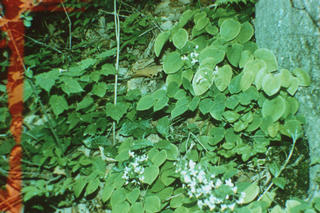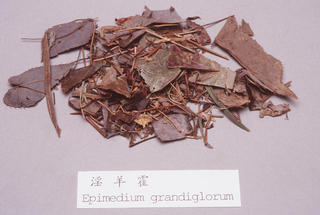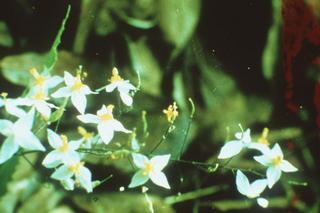Epimedium brevicornu
Contents
Nomenclature
Other Names:
Historical Use of Epimedium brevicornu
Epimedium brevicornu in Traditional Chinese Medicine
Background
Xianlingpi ÏÉÁéÆ¢
Chinese Name (pinyin): Yinyanghuo
Chinese Name :
Common Name :Epimedium
Specific Name : Herba epimedii
Scientific Name:
Collection : The drug is collected in summer and autumn when foliage branch growing luxuriantly, remove from the thick stalks and foreign matter and dried in the sun or in the shade.
Description :
Identification : To 0.5g of the powder, add 10ml of the ethanol, macerate warmly for 30 minutes, filter, evaporate the filtrate to dryness. Dissolve the residue in 1ml of ethanol as the test solution. Carry out the method for thin layer chromatography (Appendix Vl B), using silica H containing 0.5% of sodium carboxymethylcellulose as the coating substance and ethyl acetate-butanone-formic acid-water (10:1:1:1) as the mobile phase. Apply 10µl of each of the test solution and the reference solution obtained under assay to the plate. After developing and removal of the plate, dry it in the air and examine under ultra violet light (365nm). The dark red fluorescence spot in the chromatogram obtained with the test solution correspond in position and colour to the spot in the chromatogram obtained with the reference solution. Spray with aluminum chloride TS, examine again under ultra violet light (365nm), the spot turn to orange red.Assay: Standard Preparation weigh accurately 10mg of icariin CRS previously dried to constant weight at 105ºC, dissolve and dilute with methanol to volume in a 20ml volumetric flask, mix well as the reference solution (containing 0.5mg of icariin per ml)Preparation standard curve: Transfer accurately 5ml of the reference preparation to a 100ml volumetric flask, add methanol to volume and mix well. Dilute, 0.0, 1.0, 2.0, 3.0, 5.0, 7.0, 9.0ml of the resulting solution to 10ml volumetric flasks separately. Add methanol to volumn and mix well. Measure the absorbance at 270nm (appendix VA), plot a standard curve with absorbance as ordinate and concentration as abscissa.Test preparation : T about 0.5g of the leaves in coarse powder, previously dried at 80ºC for 4 hours and accurately weighed, add 20ml of 70% ethanol, accurately measured in a round bottom flask, weigh and heat under reflux for 1 hour, allow to cool and weigh again, make up the loss in weight with 70% ethanol, shake thoroughly and filter. Discard the initial filtrate, collect the successive filtrate as the test preparationProcedure: Carry out the method for thin layer chromatography (Appendix Vl B) using silica gel G as the coating substance and ethyl acetate-butanone-formic acid-water (5:3:1:1) as the mobile phase. Apply 100µl, accurately measured of the test preparation to the plate in strip and 10µl of reference preparation in spot 1.5cm beside the strip. After developing and removal of the plate, dry it in the air. Examine under ultra violet light (365nm). Scrape off and collect the strip of silica gel G showing dark red fluorescence corresponding in position to icariin in a 10ml test tube, scrape off the equal area of silica gel G from same plate and collect in another 10ml test tube as blank. Add 10ml, accurately measured of the methanol to each test tube, shake thoroughly, allow to stand for 2 hours and filter. Discard the initial filtrate and collect the successive filtrate. Measure the absorbance of the resulting solution at 270nm (Appendix V A). read out the weight (µg) of icariin in the test preparation from the standard curve and calculate the content of C33 H40 O15. The leaves previously dried at 80ºC for 4 hours contains not less then 1.0% of icariin (C33H40O15).
Processing : Eliminate foreign matter, pick the leaves, spray with water, soften slightly, cut into slivers and dry.Herba Epimedii (processed): stir fry slivers with refined suet by gently heating until an even lustre is produced, remove and let cool. Using 20kg of refined suet per 100kg of herba epimedii.
Action :
Indication : impotence, seminal emission, weakness of the limbs; rheumatic or rheumatoid arthralgia with numbness and muscle contracture; climacteric hypertension
Precautions :
Dosage : 6-10g
Storage :
Synonymns for Epimedium brevicornu
Patent Medicines and Medicines with Multiple Ingredients that include Epimedium brevicornu
Pharmaceutical Information
Chemical Constituents
Evidence or the Use of Epimedium brevicornu in the Treatment of Epilepesy
Basic Science
Animal Studies
Cohort, Case-Control and Non-Randomized Trials
Randomized Controlled Trials
Meta-Analysis
1st Five Results: pubmed search
Wang Chen, Yue Zhang, Yuhang Zhang, Zili Feng, Xu He
Efficient preparation of icariin from epimedin C by recyclable biphasic enzymatic hydrolysis.
Nat Prod Res: 2024;1-7
[PubMed:38629157]
[WorldCat.org]
[DOI]
(I a)
Baolin Wang, Qinqin Wang, Renyikun Yuan, Shilin Yang, Meilin Lu, Fuhong Yuan, Zhidan Dong, Menghuan Mo, Qiming Pan, Hongwei Gao
Prenylated chromones and flavonoids isolated from the roots of Flemingia macrophylla and their anti-lung cancer activity.
Chin Med: 2023, 18(1);153
[PubMed:37996917]
[WorldCat.org]
[DOI]
(P e)
Wenhui Yao, Rongpin Tao, Yue Xu, Zhe-Sheng Chen, Xuansheng Ding, Lisheng Wan
AR/RKIP pathway mediates the inhibitory effects of icariin on renal fibrosis and endothelial-to-mesenchymal transition in type 2 diabetic nephropathy.
J Ethnopharmacol: 2024, 320;117414
[PubMed:37977422]
[WorldCat.org]
[DOI]
(I p)
Hui Zhang, YanRu Wang, Yuhang Liang, Xu Zhao, Gang Chen
##Title##
Nat Prod Res: 2023;1-4
[PubMed:37966979]
[WorldCat.org]
[DOI]
(I a)
Meifang Wu, Naying Zheng, Xiaoxiao Zhan, Jianzhang He, Min Xiao, Zhenghong Zuo, Chengyong He
Icariin induces developmental toxicity via thyroid hormone disruption in zebrafish larvae.
Food Chem Toxicol: 2023, 182;114155
[PubMed:37898232]
[WorldCat.org]
[DOI]
(I p)


